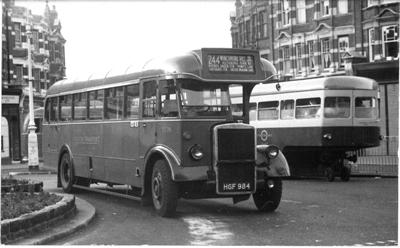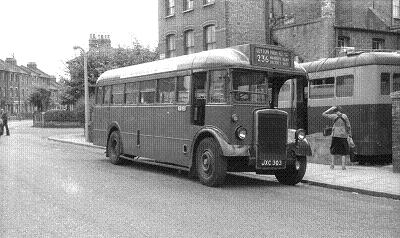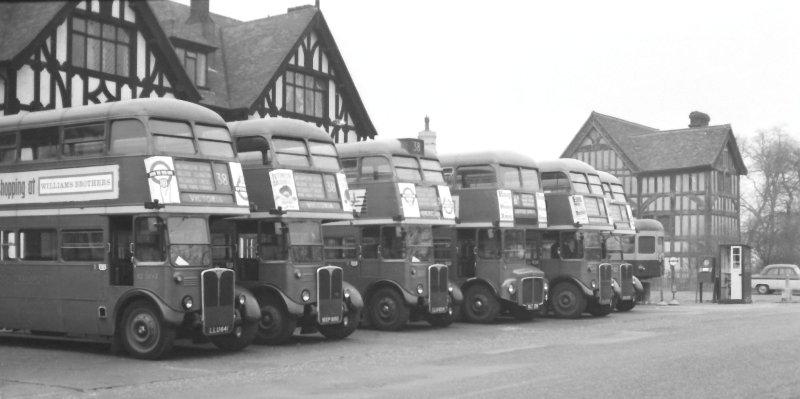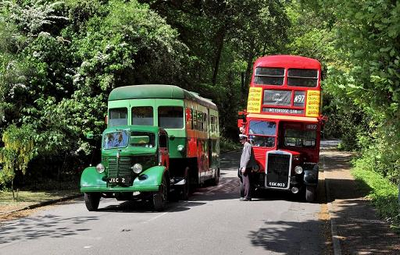 Mobile canteens Mobile canteens
Page last updated 27 July 2019
Muswell Hill Broadway, June
1952. The bus interest is provided by Weymann-bodied TD26 on
the 244 - Muswell Hill's single-deck
route that didn't convert to RF operation, because it was
double-decked with RTs in May 1953, after the 210 and 212 had
received their RF allocations. The canteen trailer was a
feature of the site until the canteen building (on the island to
the left) was opened in 1961. It is obviously a hot day, as
the trailer has its emergency door open as well as all the
windows.
Photo © Alan Cross
One of the lesser known by-ways of London Transport history is
the story of its determination to provide refreshments for its
crews. Where possible, fixed canteens were provided, either
(logically) within bus garages or in purpose-built units elsewhere
(such as the one in Plimsoll Road,
Finsbury Park). Often, bus termini would be close to
commercially operated cafés, like the one at the Leyton High Road end of the
236. The availability of refreshment facilities was a
factor considered when introducing or amending bus routes, for
example on the 211 and 97. London
Transport sometimes made payments to café proprietors to stay open
later than they would have wished in order to cover late meal
reliefs. But where there was no other provision, LT provided
a mobile canteen service. This was by special vehicles, in
the first instance converted buses and later by custom-built
trailers.
Records of these units are patchy - they did not feature in the
official records in the same detailed fashion as did LT's
buses - but the available evidence was assembled by Ian Blee in
1998 for his article in LOTS' London Bus Magazine volume 105
and we gratefully acknowledge this and the sources listed
below. The article contains much more detail on the converted
buses than is provided here.
Converted buses
The story starts in 1937, when 12 NSs, which finished service
that year, were converted to canteens. The canteens
were initially envisaged to provide crew catering at special
events, including the Coronation in 1937, or garage
rebuilds. It is suggested that regular use at terminal
locations was only considered once they had become available.
Their use increased substantially during the war, including
providing temporary support for facilities that had been
bombed. After the war, the NSs were supplemented by six
converted Tilling STs - one of which, ST922, survived to be
converted back to a bus in preservation (it is shown in use as a
canteen here).
The converted buses were part of the service vehicle fleet. The
former NSs were numbered 29H to 40H, whilst the former STs
became 688J-693J.
The ex-Tilling ST canteens were always Central bus red all over
with black wings and brown roof. On conversion, the
NSs were in Central bus livery - red and white, with black
wings and silver roof. During the war the roofs were repainted
grey, then early post war brown. Those known to have kept
this livery up to withdrawal are 33H and 40H. Others
including 35H, 38H and 39H received the early postwar Central bus
all-over red livery but with brown roof; 39H was painted green in
May 1941, then khaki and back to red in February
1946. The single-deck canteen, 31H, was
originally red and white, khaki from 1940 to 1946 and later
all over red. In later years when it was the Hatfield
(old HF garage) canteen, 30H was painted green. 34H was grey
from 1945 to 1946.
The NSs and STs were all withdrawn by 1953, except for ST922
which was at Belmont until late
1954, so any facilities provided thereafter would have used
trailers.
Canteen trailers
In 1947, as part of the post-war improvement programme, LT
introduced the first of a fleet of 13 purpose-built articulated
canteen trailers, together with ten Bedford O tractor units to take
them to and from their operating location. Note that canteens
were usually taken back to their base garage each evening for
re-supply (from the Food Production Centre at Croydon); the
Bedford units would have been driven by inside staff. The
trailers were 30 feet long and were built by Spurlings on Scammell
chassis, and were painted in two-tone green. The only
surviving tractor and trailer are preserved at the
London Bus Museum (see photo at foot of page).
 The Finsbury Park location for one
of the trailers in July 1958. This is Plimsoll Road, near the junction
with Ambler Road, east of the location of the permanent canteen
that opened later that year. By the looks of it, the trailer
may not have been returned to its home garage each night.
Again the bus is a TD, this time Leyton Garage's TD110, one of the
Mann Egerton-bodied examples. The 236 was converted to RF operation four months
later. The Finsbury Park location for one
of the trailers in July 1958. This is Plimsoll Road, near the junction
with Ambler Road, east of the location of the permanent canteen
that opened later that year. By the looks of it, the trailer
may not have been returned to its home garage each night.
Again the bus is a TD, this time Leyton Garage's TD110, one of the
Mann Egerton-bodied examples. The 236 was converted to RF operation four months
later.
Photo © John Boylett at SCT61.
A Pathe Newsreel from 1947 available on YouTube shows the
first unit (700B with trailer) in Ealing, emerging from
Hollingbourne Gardens to take up position in front of an STL on the
65 in Cleveland Road, the Ealing Argyle Road
stand. The film gives a good idea of the sheer
scale of the vehicle, but was taken in a special shoot and does not
reflect the actual daily movement.
We have attempted to summarise the known locations of the
post-war trailers, based on Ian Blee's article, memories
provided by LT staff recorded elsewhere on this site and other
contributions. Additional information and more stories
would be most welcome, by
e-mail. Unit numbers refer
to the tractor units (700B to 709B) as the trailer details were not
recorded (note that trailers originally carried a painted
registration number for the tractor to which they were paired,
although this was only semi-permanent).
It is apparent from the listing that the requirement for the
units reduced significantly by the mid- to late 50s, due mainly to
the provision of permanent canteens. The first units were placed
into store at that time and the first two were sold (to Liverpool
Corporation for further use) in 1959. The last tractor units were
sold in 1967, but at least six trailers were retained by London
Transport until 1969. Ian notes that the last few
trailers outlived the Bedford tractors and were moved in their
final years by Thames Trader 1325F (photo here)
(and possibly other contemporary tractor units); the last in
regular use appear to be those at Ealing Argyle Road and
Chingford Royal Forest Hotel.
Location of canteen trailer
units
Long-term
locations
Aldgate Minories Bus
Station Trolleybus, coach and bus
terminus. A trailer replaced a temporary wooden
structure in early 1951, and was in use until a permanent tea
bar was opened in July 1964. Garage allocation not known, but
may have been Dalston, to which the former Arnos Grove unit 705B
was transferred in 1951 (there is a photograph from the early 1960s
of a Dalston RF with blank blinds parked next to the Aldgate
trailer, perhaps being used by the garage engineers?).

An early-60s line-up at
Chingford Royal Forest Hotel, with the canteen trailer in
its accustomed place at the far end of the line. Leyton's RTs
3842, 4627 and 1914 are on route 38, Walthamstow's RM170 on the
6B and two more RTs on the 179 (probably) and
102. Note also the time clock by the canteen.
Photo © Stuart Johnson
Chingford Royal Forest
Hotel The well-known terminus of many
routes, including 38 and 121, featured a mobile catering
facility on the hotel forecourt from December 1937 to
September 1968, when the terminus was moved to the
station. The first was mobile tea bar 225M, a tiny
Morris 5-cwt van, and was replaced by an NS in 1940.
A trailer replaced this in 1948 or 1949, one of the early
units being 704B. Garage allocation not known, possibly
Loughton?
Clapham Junction St John's
Hill Initially used as a terminus for
tram replacement bus routes, and still in use today, this site
hosted a canteen relocated from Prested Road (closer to the
station) from October 1950. 707B was based at Stockwell
Garage until 1956; it is not known whether this represented
the end of canteen facilities at the site.
Ealing Argyle Road
Terminus of the 65. Canteen based at
Southall (known as Hanwell until 1950) Garage, and was introduced
with the first of the new units in April 1948; after 700B, 701B was
allocated from 1953 to 1962. In the 1960s it operated Monday to
Friday only, until at least 1966 and probably 1968, after which the
65 used the terminus only at peak hours. See the YouTube link
mentioned above and notes on the 211
page; the trailer was parked close to the 65 stand, not as shown on
the video.
Finsbury
Park An NS mobile canteen
was provided in Station Place from March 1938. At an unknown date,
this was replaced by a trailer unit, possibly as late as December
1951, when 703B was allocated to Holloway Garage. At a later date,
probably September 1953 when the scanty records show the Station
Place facility closed, the facility moved to a vacant site in
Plimsoll Road (terminus of the 19 and 236
since 1930); the picture above shows the trailer firmly in place by
July 1958. The facility continued until the opening of the Plimsoll Road canteen on 20 October
1958 (probably LT's smallest, with seating for only 16).
Hayes Blyth
Road Converted ST 691J, based at
Uxbridge, was located at this well-used but off-the-beaten-track
terminus for Hayes Station on Sundays from 14 Aug 47. On or
about 20 Apr 50, it was replaced by a canteen trailer daily,
drawn by 708B based out of Hounslow. It is not know
how long the facility remained, although the terminus continued in
use beyond the last of the mobile canteens. This location is
not included in Ian Blee's article; the above details are from the
LT publication 'Position of Mobile canteens' and a trailer
is reported by two correspondents as present on several
occasions up to at least 1956 - on one occasion, two trailers were
reportedly present.
Muswell Hill Broadway The
terminus of the 212, 244 and 43/134 short
workings, illustrated at the top of the page. A mobile
facility was provided from July 1948 and was replaced by a canteen
in the 'chalet' in the centre of the turning circle in November
1961. 705B was based at Muswell Hill from 1948 to 1951, 708B
from 1953 to 1966. See also Arnos Grove.
West Green Garage West Green (the
former Admiral garage, home to route 233
amongst others) had no canteen, and was provided with a mobile
canteen from 1937, presumably (but unconfirmed) until it closed in
1962.
Other locations
Arnos Grove Station Terminus of the
251. The earlier facility using an
NS was replaced, after October 1948 (when it was photographed by
Alan Cross), by a canteen trailer. This remained until
the canteen at the station opened in January 1950.
Units were based at Muswell Hill Garage - see Muswell Hill
Broadway.
Becontree Heath It is believed that
a mobile canteen was provided from 1952 to 1954, at which point the
canteen was provided at the new bus stand. 702B was based at
Barking during that time.
Chelsham Garage A trailer replaced
NS2295 at CM in 1950. The permanent canteen opened in
December 1952.
East Grinstead Garage A trailer
unit was in use here from May 1952 to March 1953, when the garage
canteen opened.
Eltham Well Hall Station
Terminus of route 228, amongst
others. A trailer unit was based here from July to
September 1952 until the permanent canteen opened in that
autumn. Garage allocation not known.
Hampton Court An NS mobile canteen
was provided here from about 1937 until after the war.
It is not known whether the site ever hosted a trailer.
Harrow Road A canteen
trailer was located in Harrow Road from June 1948. Ian Blee
says 'presumably near the Prince of Wales' junction, but this
is unclear. 703B was based at Middle Row Garage from
September 1948 to September 1951. It is not known when the
facility was withdrawn, but Westbourne Park Station had a permanent
canteen from June 1951.
Harlow A mobile canteen was located
in Harlow from July to (at least) December 1956, during which time
704B was allocated to Epping Garage. It is not know how long
the mobile facility was provided, but it had gone before the new
Harlow Garage replaced Epping in May 1963.
Hatfield Garage The last surviving
NS canteen was located at Hatfield and was 'plumbed in'. It
lasted until 1953; it is not known whether it was replaced by a
mobile or fixed canteen, but in 1958 a 'new or refurbished' canteen
opened there.
High Barnet Station Not a bus
terminus; the canteen was presumably for use by Underground
staff. In use from April 1949 to March 1954, when a canteen
was opened in the station. Garage allocation not known, but
see Potters Bar.
Highbury Barn Terminus of the 19
(Battersea Garage workings, see notes under Finsbury Park). The NS located at
Highbury Barn was replaced by a canteen trailer some time between
1948 and 1951. 705B was allocated to Dalston from February
1951 to June 1953 (but see Aldgate). It is not known when the
facility was withdrawn or what replaced it.
Hitchin Garage A mobile canteen was
provided from 1953 (variously reported as October or December)
until the permanent canteen opened in August 1954. 706B and
705B were each briefly allocated during this period. It is
reported that crews also patronised Bottoms' Cafe on the opposite
side of the road by the old Maltings.
Plumstead Common From March 1937,
an NS and later an ST were based here, replaced (possibly in
January 1949, when ST867's allocation to Plumstead ended) by a
trailer unit. The canteen was provided (but not continuously,
as there were insufficient units) until January 1956; a café was
available from then (see Alan Neale’s
notes). See also Woolwich.
Potters Bar Not a canteen location,
but 709B was allocated to PB from 1949 to 1955. It is not
known where this was used - possibly High Barnet? (see above)
Stoke Newington Common A mobile
canteen was provided from April 1950 until a new canteen opened in
May 1953. 706B was allocated to Tottenham Garage from 1948 to
1953.
Uxbridge Station Former ST 691J was
located at Uxbridge Station until 1950, in the location of the
current bus garage, but is not recorded as being replaced by a
trailer. It may be that bus crews henceforth used the
Underground station canteen.

The London Bus Museum has
preserved tractor and trailer 702B, seen here in Redhill Road with
the Museum's RTL.
Photo © Peter Zabek
Vauxhall Cross An NS mobile canteen
was provided here from about 1937 until after the war,
although the exact location is not known; nor is whether the
site ever hosted a trailer.
Victoria Buckingham Palace
Road NS and, later, ST units were
replaced in October 1948 by 701B, based at Gillingham Street
Garage. This allocation continued to June 1951, after which
there are no further records.
Woolwich Beresford Square
Details uncertain. A canteen moved to a new site after the
last trams ran at Woolwich in June 1952, but this may have been an
ST, not a trailer. See also Plumstead Common.
In addition to the permanent locations listed above, canteen
trailers were used at special events such as Ascot, the Derby and
Wimbledon.
Greenford Red Lion has been removed from the above
list. Keith Williams, who remembers the ST (689J, which was
allocated to Alperton Garage), does not think this was replaced by
a trailer but that crews thenceforth used a café in the
market. For more, see route 211.
Sources
London Transport Mobile Canteens,
Ian Blee, LBM 105, LOTS
SUP15, Service Vehicles, LOTS
Meals on wheels - The London
Transport Mobile Canteen, Alan Barnes, Old Glory, January 2012
London Transport Service Vehicles,
Kim Rennie & Bill Aldridge, Capital Transport 2003
www.ampyx.org.uk/lcountry/garages, Jonathan
Wilkins
www.ltsv.com, Tom Young
Personal recollections by a number
of contributors, with thanks for taking the trouble to get in
touch.
|